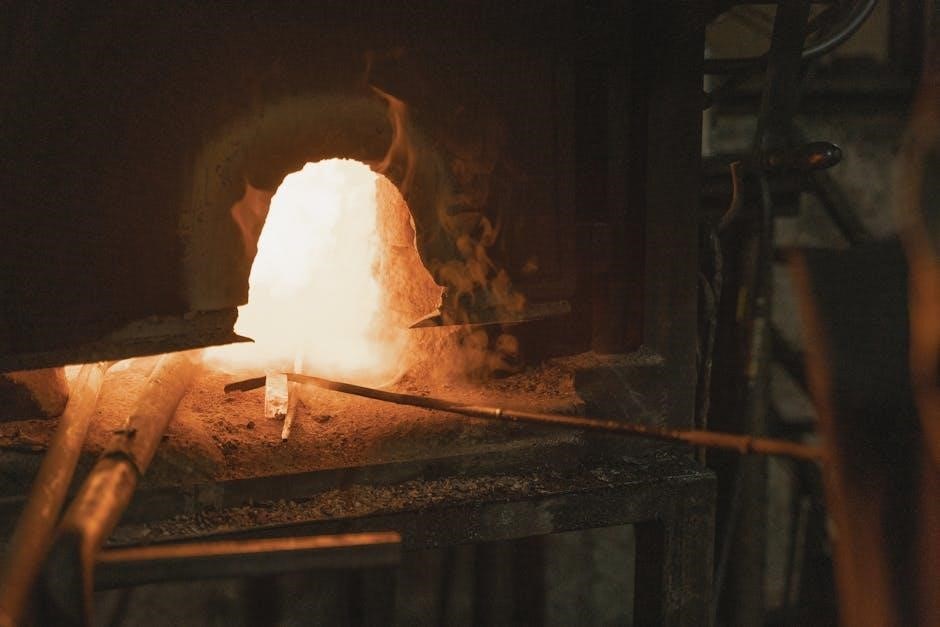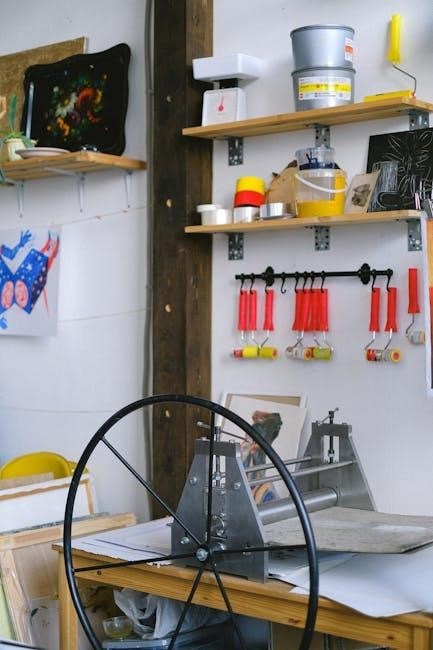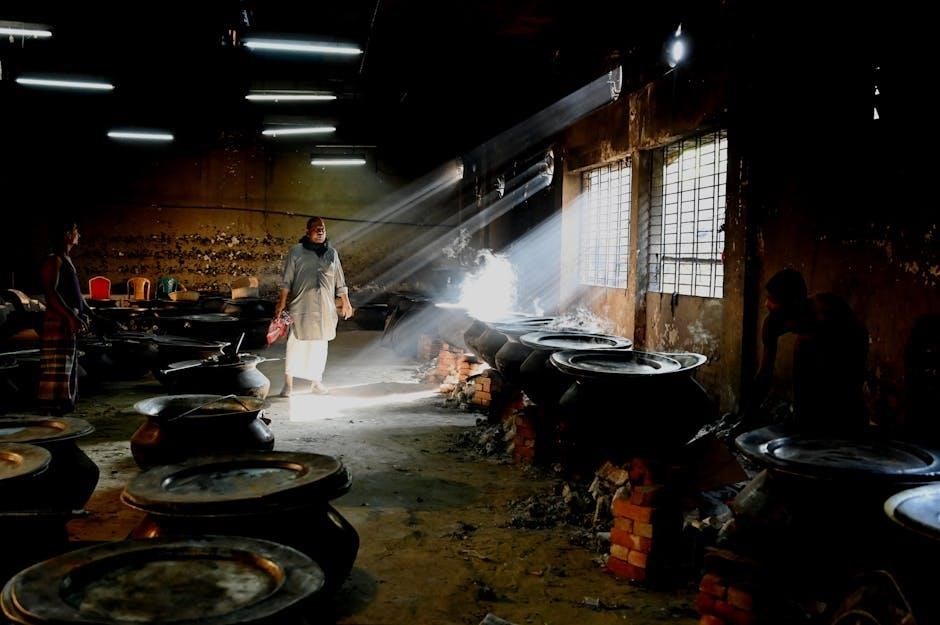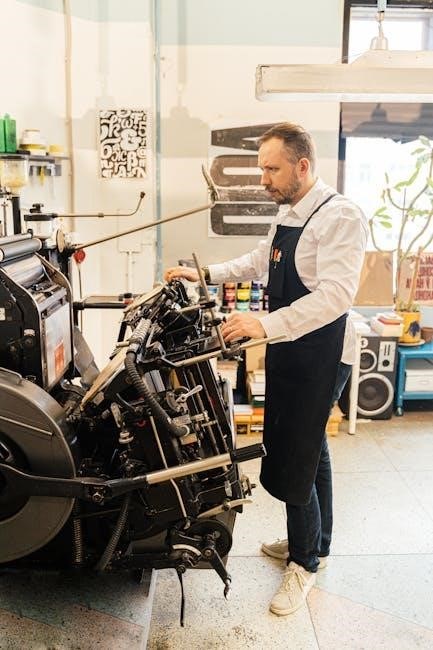
A comprehensive guide for heat press users, detailing setup, operation, and safety measures. Covers manual and automatic models, temperature control, and material-specific settings for optimal results.
Overview of Heat Press Machines
Heat press machines are essential tools for transferring designs onto materials like fabric, mugs, and glass. They apply heat and pressure to ensure vibrant, durable results. Available in manual, automatic, swing away, and clamshell models, these machines cater to various needs. The manual provides step-by-step guidance for setup, operation, and troubleshooting. Key features include digital temperature control, pressure adjustment, and safety mechanisms like auto-shutdown and overheat protection. Ideal for sublimation, heat transfer vinyl (HTV), and screen printing, heat presses are versatile for both hobbyists and professionals. Proper usage ensures consistent, high-quality outcomes across diverse applications.
Importance of Reading the Manual
Reading the heat press manual is crucial for safe and effective operation. It provides detailed instructions for setup, temperature control, and material-specific settings, ensuring optimal results. The manual highlights safety features like auto-shutdown and overheat protection, preventing accidents. Understanding proper usage prevents damage to machines and materials. It also guides troubleshooting common issues like uneven pressure or incorrect temperatures. By following the manual, users can maintain machine longevity and achieve consistent, professional-quality transfers. It’s essential for both beginners and experienced users to refer to the manual for specific models, as settings and features may vary.
Key Components of a Heat Press
A heat press consists of essential components that ensure efficient operation. The heating plates are the core, transferring heat evenly to materials. Pressure adjustment knobs or dials allow precise control for consistent results. Digital temperature control enables accurate heat settings, crucial for various materials. Insulation surrounds the plates to retain heat and prevent energy loss. The platens, or pressing surfaces, are designed for durability and even heat distribution. Hinges and springs provide smooth opening and closing mechanisms, while a digital timer ensures precise control over pressing time. These components work together to achieve professional-quality transfers and prints.

Types of Heat Press Machines
Heat press machines vary in design and functionality, catering to different needs. Manual presses are cost-effective and simple, while automatic presses offer advanced features for high-volume use. Swing-away and clamshell models provide unique opening mechanisms for safe and efficient operation. Each type is tailored to specific applications, ensuring versatility for diverse crafting and industrial requirements.
Manual Heat Press
A manual heat press is a cost-effective and simple machine ideal for small-scale projects. It operates using manual pressure, requiring the user to apply force via a handle. This type is perfect for home-based crafters or small businesses, offering precise control over pressure and temperature. Manual presses are lightweight and portable, making them easy to store and transport. They are also relatively low maintenance, with fewer mechanical parts compared to automatic models. While they may require more effort, manual heat presses are reliable for basic heat transfer tasks. Always refer to the manual for specific instructions on operation and safety precautions.
Automatic Heat Press
An automatic heat press is a high-efficiency machine designed for large-scale production. It features a motorized mechanism that applies consistent pressure and temperature, reducing manual effort. This type is ideal for businesses with high-volume orders, as it streamlines the pressing process. Automatic heat presses often include advanced digital controls, enabling precise temperature and time adjustments. They are durable and built for continuous use, making them a worthwhile investment for professional settings. Always consult the manual for specific operational instructions to ensure optimal performance and safety. Maintenance tips are also provided to extend the machine’s lifespan and functionality.
Swing Away Heat Press
A swing away heat press features a unique design where the upper heating platen swings to the side, allowing easy access to the work surface. This design is ideal for intricate projects, as it eliminates obstruction during material placement. It is popular among crafters and small businesses due to its versatility and ease of use. The swing-away mechanism ensures safer operation, as the heat source moves away from the user. For optimal performance, refer to the manual for setup and maintenance instructions. Regular lubrication of hinges and proper alignment are crucial for longevity and consistent results.
Clamshell Heat Press
A clamshell heat press operates with an opening and closing mechanism similar to a shell, providing easy access to the work surface. This design is highly popular in commercial settings due to its efficiency and durability. The clamshell model often features a large pressing area, making it suitable for bulk production. Its heavy-duty construction ensures consistent performance over time.
For optimal use, the manual recommends regular maintenance, such as cleaning the heating elements and ensuring proper alignment. This press is ideal for high-volume applications, offering precise temperature and pressure control for professional-grade results. Always follow safety guidelines to avoid accidents during operation.

Heat Press Machine Components
A heat press consists of heating elements, pressure systems, and a frame. These components work together to apply heat and pressure evenly for consistent results.
Heating Plates
The heating plates are essential components of a heat press, responsible for generating and transferring heat evenly. Typically made of durable materials like aluminum or steel, they ensure consistent heat distribution. Proper maintenance, such as cleaning and avoiding extreme temperature fluctuations, is crucial for longevity. The plates’ design varies, with some models featuring flat or curved surfaces for specific applications. Always refer to the manual for guidance on optimal temperature settings and care instructions to prevent damage and ensure efficient performance.
Pressure Adjustment
Pressure adjustment is crucial for achieving optimal results with a heat press. Proper pressure ensures even contact between the heating plate and the material, preventing under-pressure issues like incomplete transfers. Most machines feature adjustable knobs or levers to customize the force based on the material’s thickness and type. Over-tightening should be avoided to prevent damage to the machine or substrate. Always refer to the manual for specific pressure recommendations tailored to your heat press model and the materials you’re working with, such as vinyl, fabric, or sublimation paper. Correct pressure settings enhance both quality and machine longevity.
Digital Temperature Control
Digital temperature control is a key feature of modern heat press machines, allowing precise regulation of heat settings. This feature ensures consistent results by maintaining the set temperature throughout the pressing process. Most machines include an LCD screen for easy monitoring and adjustment of temperature, with controls to increase or decrease the heat as needed. Proper temperature settings are critical for specific materials, such as sublimation prints or heat transfer vinyl. Always refer to the manual for recommended temperature ranges. Accurate control prevents overheating and ensures optimal transfer quality, making this feature essential for achieving professional-grade results in various applications.
Insulation and Safety Features
Proper insulation and safety features are crucial for safe and efficient heat press operation. High-quality machines are designed with thermal insulation to retain heat and protect users from burns. Safety features include overheat protection, which automatically shuts off the machine if temperatures exceed safe levels. Many models also include an emergency release mechanism to instantly open the press in case of an accident. Insulation materials ensure heat is evenly distributed while keeping exterior surfaces cool. These features not only prevent accidents but also prolong the machine’s lifespan by preventing overheating. Always check that safety mechanisms are functioning correctly before use to ensure a secure working environment.

Safety Features and Precautions
Safety features and precautions are essential for operating a heat press. Always wear protective gloves and eyewear, and ensure proper ventilation in the workspace. Follow the manual’s guidelines to avoid accidents and maintain a safe working environment.
Overheat Protection
Overheat protection is a critical safety feature in heat press machines. It prevents the machine from exceeding a safe temperature threshold, which could cause damage or pose a fire hazard; This feature is typically monitored by sensors that detect temperature levels and automatically shut down the machine if overheating occurs. Always ensure this feature is functioning properly before use. Regular maintenance, such as cleaning the machine and checking for blockages, can help prevent overheating. Refer to your manual for specific instructions on how to test and maintain this essential safety mechanism to ensure safe and reliable operation.
Auto-Shutdown Feature
The auto-shutdown feature is a convenient and safety-enhancing mechanism that automatically powers off the heat press machine after a predetermined period of inactivity or when it reaches a specific temperature. This feature not only helps conserve energy but also prevents accidental damage from prolonged operation. It is especially useful in busy environments where the operator might forget to turn off the machine. Always refer to your heat press manual to understand how this feature works and how to adjust settings for optimal performance. Regularly check the auto-shutdown function to ensure it operates correctly and safely.
Emergency Release Mechanism
The emergency release mechanism is a critical safety feature designed to allow quick and easy opening of the heat press in case of an emergency. Typically located near the operating handle, this mechanism ensures rapid disengagement of the press, preventing accidents or injuries. Always familiarize yourself with its location and operation before using the machine. Refer to your heat press manual for specific instructions, as designs may vary. Proper handling and understanding of this feature are essential for safe and efficient operation. Regularly test the mechanism to ensure it functions correctly when needed.

Operational Steps
Operational steps involve preheating, setting temperature/time, placing materials, and initiating the press cycle. Ensure all settings align with the material type for optimal results.
Preheating the Machine
Preheating ensures even heat distribution and prepares the machine for pressing. Turn on the heat press and set the desired temperature. Keep the machine closed during preheating to maintain heat. Allow 10-20 minutes for the heating plates to reach the set temperature. Use a temperature gun to verify consistency across the plates. For materials like vinyl or sublimation, preheat to 200-300°F. Adjust power levels if necessary to avoid overheating. Always refer to the manual for specific preheating guidelines. Proper preheating is crucial for achieving professional results in heat pressing applications.
Setting the Temperature and Time
Accurate temperature and time settings are crucial for optimal results. Refer to the material’s specifications for ideal ranges. For heat transfer vinyl, set temperatures between 250-300°F and time between 10-20 seconds. Sublimation requires higher temperatures (300-400°F) and slightly longer times (30-60 seconds). Use the digital controls to adjust settings precisely. Ensure the machine maintains consistent heat throughout the cycle. Always test settings on scrap material first to avoid errors. Proper calibration ensures vibrant, durable prints. Adjustments may be needed based on material thickness or special finishes. Follow the manual for specific guidelines tailored to your machine model.
Placing the Material
Properly positioning the material on the heat press is essential for achieving professional results. Always place the material centered on the lower platen, ensuring it is aligned with the heating plate. Smooth out any wrinkles or air bubbles to prevent uneven pressure. For best results, use a heat-resistant tape to secure lightweight materials. Ensure the design is face down and aligned with the press’s center. Double-check that the material is within the press’s capacity and evenly distributed. Proper placement ensures consistent heat transfer, vibrant colors, and a professional finish. Always refer to the manual for specific material placement guidelines.
Starting the Press Cycle
Once the material is correctly placed and the settings are confirmed, initiate the press cycle. Ensure the heat press is preheated to the correct temperature and the timer is set according to the material’s requirements. Gently close the press, making sure there are no obstructions. Press the start button to begin the cycle. The machine will apply heat and pressure evenly. Avoid interrupting the cycle once it has started, as this may damage the material or the press. Always keep a safe distance and monitor the press during operation. Refer to the manual for specific cycle start procedures and safety guidelines.
Cooling Down the Machine
After completing the press cycle, allow the heat press to cool down gradually. Avoid sudden temperature drops, as this can damage the heating elements. Turn off the power and let the machine cool naturally. For faster cooling, some models have a built-in cooling fan or ventilation system. Ensure the machine is in a well-ventilated area to prevent overheating. Never pour water or use wet cloths to cool it down, as this can cause electrical damage. Always clean the heating plates before cooling to prevent residue buildup. Refer to the manual for specific cooling instructions to maintain optimal machine performance and longevity.

Materials and Applications
The heat press works with various materials like fabric, plastic, and metal for custom designs. Ideal for sublimation, HTV, and screen printing, it’s perfect for creating logos, promotional items, and personalized gifts.
Sublimation Printing
Sublimation printing is a popular technique using heat presses to transfer vibrant, full-color designs onto materials like fabric, ceramics, and metal. The heat converts sublimation ink into gas, embedding it into the material for a permanent, high-quality finish. Ideal for custom clothing, mugs, and promotional items, this method requires precise temperature and pressure settings to ensure proper ink adhesion. The heat press manual provides detailed guidelines for optimal sublimation results, ensuring professional-grade outputs for various creative and commercial applications. This method is favored for its durability and photorealistic outcomes, making it a staple in both hobbyist and industrial settings.
Heat Transfer Vinyl (HTV)
Heat Transfer Vinyl (HTV) is a versatile material used for customizing fabrics, such as t-shirts, hoodies, and bags. It is cut into designs, weeded, and applied using a heat press. The heat press manual provides specific temperature and time settings for pressing HTV, ensuring proper adhesion and durability. HTV is ideal for both personal and professional projects, offering a wide range of finishes like glossy, matte, and metallic; Following the manual’s guidelines ensures long-lasting results with vibrant colors and a professional finish. Proper application techniques prevent peeling or discoloration, making HTV a popular choice for custom apparel and textiles.
Screen Printing
Screen printing is a popular technique for creating vibrant, high-quality designs on fabrics and other materials. While traditionally done with manual screens, heat presses enhance the process by curing the ink quickly and evenly. The heat press manual provides guidelines for temperature and time settings to ensure proper ink adhesion and durability. Screen printing paired with heat pressing offers crisp, long-lasting results, ideal for bulk orders or intricate designs. Proper alignment and pressure are crucial for achieving professional-grade prints. This method is widely used in custom apparel, signage, and promotional products, making it a versatile option for both hobbyists and professionals.
Mixed Media Applications
Mixed media applications combine multiple techniques to create unique designs, and heat presses are essential for achieving professional results. The heat press manual details how to layer materials like fabric, metal, and wood, ensuring proper adhesion. Techniques such as sublimation, HTV, and screen printing can be blended for intricate designs. The manual provides guidelines for temperature, pressure, and cycle times to ensure compatibility between materials. Mixed media applications are ideal for creative projects, offering endless possibilities for artisans and crafters. Whether for personal use or professional production, heat presses simplify the process of combining diverse materials into stunning, durable creations.

Troubleshooting Common Issues
The heat press manual provides solutions for common issues like incorrect temperature settings, uneven pressure, or malfunctioning parts, ensuring smooth operation and optimal results.
Incorrect Temperature Settings
Incorrect temperature settings are a common issue that can lead to poor printing results. The heat press manual guides users to check the temperature calibration and adjust it according to the material being used. Ensure the machine is preheated to the recommended temperature for your specific application, as outlined in the manual. If the temperature is too low, the ink may not adhere properly, while excessively high heat can damage the substrate. Use a thermometer to verify accuracy and refer to the manual’s temperature chart for precise settings. Adjusting the temperature correctly ensures optimal results and prevents damage to the machine or materials.
Uneven Pressure Distribution

Uneven pressure distribution can cause inconsistent printing results. The heat press manual advises checking the pressure adjustment knob to ensure even force across the heating plate. Misaligned or loose springs may also contribute to this issue. Ensure the pressure is evenly distributed by tightening the springs or adjusting the machine’s alignment. Using a pressure gauge or test paper can help identify uneven areas. Regularly inspect and maintain the press to prevent this problem. Uneven pressure can lead to incomplete transfers or damaged materials, making proper adjustment crucial for achieving professional-quality results.
Ink Not Adhering Properly
Ink not adhering properly is a common issue in heat pressing. Check if the temperature and time settings match the material and ink type. Incorrect settings can prevent proper adhesion. Ensure the heating plate is clean and free from dirt or residue, as contamination can block ink transfer. Test the press on scrap material to confirm settings. If the issue persists, consult the manual for specific recommendations. Verifying ink and material compatibility is crucial for achieving desired results. Adjustments may be needed for different ink types or substrates to ensure proper adhesion and durability of the print.

Maintenance and Care
Regular maintenance ensures optimal performance and extends the lifespan of your heat press. Clean heating plates, lubricate moving parts, and store the machine properly when not in use.
Cleaning the Heating Plates
Cleaning the heating plates is essential for maintaining consistent heat distribution and preventing residue buildup. Use a soft, lint-free cloth to wipe down the plates, ensuring they are cool to avoid burns. Avoid abrasive materials or harsh chemicals, as they can damage the surface. For tough residue, dampen the cloth with distilled water, but never submerge or soak the plates. Regular cleaning after each use prevents ink, vinyl, or sublimation residue from hardening. Always dry the plates thoroughly to avoid rust or moisture damage. Clean heating plates ensure accurate temperature control and prolong the machine’s lifespan. Perform this maintenance routinely for optimal performance.
Lubricating Moving Parts
Lubricating moving parts is crucial for smooth operation and preventing wear. Use a high-quality silicone-based lubricant, applied sparingly to hinges, gears, and pivot points. Avoid over-lubrication, as excess oil can attract dust and create maintenance issues. Wipe off any excess with a clean cloth to ensure proper function. Lubricate every 50 uses or when you notice increased friction. Regular lubrication ensures the machine operates quietly and efficiently, reducing the risk of mechanical failure. Always refer to the manual for specific lubrication points and recommended products to maintain optimal performance and extend the machine’s lifespan.
Storing the Machine
Properly storing your heat press machine is essential for maintaining its performance and longevity. Always disconnect the power cord and allow the machine to cool down completely before storage. Wipe down the heat plates and other surfaces with a soft cloth to remove any debris or residue. Cover the machine with a protective cover to prevent dust accumulation. Store it in a cool, dry place away from direct sunlight and moisture. Ensure the storage area is stable and free from potential hazards. Regularly inspect the machine before use after storage to ensure it remains in good condition.

Resources and Downloads
Access official heat press manuals, guides, and software updates on manufacturer websites or trusted online marketplaces. These resources ensure optimal performance and safety for your machine.
Where to Find Heat Press Manuals
Heat press manuals are typically available on the manufacturer’s official website or provided with the machine upon purchase. For those seeking digital versions, platforms like Amazon, eBay, or specialized equipment forums often host downloadable PDFs. Additionally, many brands offer user guides and troubleshooting resources on their support pages. Always ensure to download manuals from trusted sources to avoid counterfeit or outdated information. If you cannot locate the manual, contacting the manufacturer’s customer service team is a reliable option. Online communities and crafting groups may also share PDF versions tailored for specific models or applications, ensuring easy access to essential guidance.
Temperature and Time Guide
A heat press manual PDF typically includes a detailed temperature and time guide to ensure optimal results for various materials. For sublimation printing, temperatures often range between 300-400°F (150-200°C), with press times of 3-5 minutes. Heat transfer vinyl (HTV) may require lower temperatures, around 275-325°F (135-165°C), with shorter press times of 10-20 seconds. Specific materials like ceramics, fabric, or metal may need adjusted settings. Always refer to the manufacturer’s guide for precise temperature and time recommendations, as overheating can damage materials. A temperature and time chart is usually provided for quick reference, ensuring accurate and safe operation.
Advanced Techniques and Tips
For experienced users, the heat press manual PDF often includes advanced techniques to enhance creativity and efficiency. Layering inks or materials can create intricate designs, while multi-color printing requires precise alignment. Using pressure evenly is key for professional results. Experimenting with temperature and time settings can achieve unique effects. Test prints are crucial before final production. Protective sheets can prevent ghosting or ink transfer. Peel techniques, such as hot or cold peeling, depend on material type. Advanced users can explore mixed-media applications or custom settings for specialty items. Always refer to the manual for safety and optimal performance. Practice makes perfect in mastering these techniques.